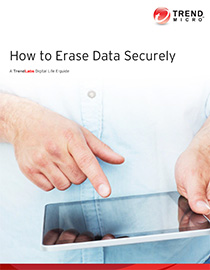How to Erase Data Securely
January 17, 2014
 View guide: How to Erase Data Securely
View guide: How to Erase Data Securely
Many people don’t think about the risks that come with disposing of old and busted gadgets. In truth, any device that can store data—old laptops, flash drives, data discs, smartphones, digital audio players, and the like—regardless if they’re still functioning properly, is a liable cause of information theft.
Anybody who’s determined enough to get the data they need can easily pick up a discarded gadget and mine it for the information they need. This can include account credentials they can reuse, sensitive media like photos and videos for blackmail, or top secret work files they can sell.
Deleting these files may seem to do the trick, but there are actually ways to recover them from the void. And though formatting a device looks like the best solution, it really just won’t do. If you’re really keen on wiping the slate clean, you can do one of three things:
- Wipe your data. Instead of just dumping your old data into random sectors in your machine’s memory, wiping makes sure that your old data is replaced. You can do this by using a trusted data wiping software that will overwrite all sectors of your laptop or PC.
- Degauss your drive. The process of degaussing involves magnetizing your machine’s hard drive, rendering it useless. After this process, no one will be able to access or store any data on it any longer.
- Wreck your drive, physically. This could be fun, but also a bit dangerous. When using power tools or the good old boot to destroy your device, make sure to wear protective gear. And once it’s all in pieces, make sure to throw it out properly. Check out electronics recycling or disposal centers who might find use for your junk.
Of course, these options are limited to data on PCs and laptops, but it’s a different matter altogether when it comes to data stored on mobile devices or even in the cloud. Our e-guide, How To Erase Data Securely, has more information on how you can permanently be rid of your digital garbage on all devices and platforms.
HIDE
Like it? Add this infographic to your site:
1. Click on the box below. 2. Press Ctrl+A to select all. 3. Press Ctrl+C to copy. 4. Paste the code into your page (Ctrl+V).
Image will appear the same size as you see above.
Posted in Online Privacy, Guides
Recent Posts
- LLM as a Judge: Evaluating Accuracy in LLM Security Scans
- The Silent Leap: OpenAI’s New ChatGPT Agent Capabilities and Security Risks
- Trend Micro State of AI Security Report 1H 2025
- The Road to Agentic AI: Navigating Architecture, Threats, and Solutions
- Exploiting Trust in Open-Source AI: The Hidden Supply Chain Risk No One Is Watching
 Trend Micro State of AI Security Report 1H 2025
Trend Micro State of AI Security Report 1H 2025 AI in the Crosshairs: Understanding and Detecting Attacks on AWS AI Services with Trend Vision One™
AI in the Crosshairs: Understanding and Detecting Attacks on AWS AI Services with Trend Vision One™ Trend 2025 Cyber Risk Report
Trend 2025 Cyber Risk Report The Road to Agentic AI: Navigating Architecture, Threats, and Solutions
The Road to Agentic AI: Navigating Architecture, Threats, and Solutions